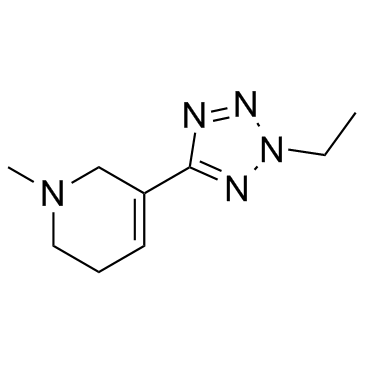Alvameline (Lu 25-109) (Synonyms: Lu 25-109) |
| Catalog No.GC30996 |
L'alvaméline (Lu 25-109) (Lu25-109) est un agoniste partiel de M1 et un antagoniste M2/M3.
Products are for research use only. Not for human use. We do not sell to patients.

Cas No.: 120241-31-8
Sample solution is provided at 25 µL, 10mM.
Alvameline (Lu25-109) is a partial M1 agonist and M2/M3 antagonist.
Alvameline is metabolized by human liver microsomes to Lu 31-126 mainly by CYP2D6; to Lu 29-297 and Lu 25-077 mainly by CYP1A2, CYP2A6, CYP2C19, and CYP3A4; and to Lu 32-181 by CYP1A2 and possibly by CYP2C19. One metabolite, Lu 32-181, could be reduced back to alvameline, a reaction not inhibited by the applied cytochrome P-450 inhibitors[1].
Alvameline competitively and effectively antagonizes carbachol-induced contractions and contractions induced by electrical field stimulation in human detrusor muscle. Alvameline produces a concentration-dependent rightward shift of the concentration-response curves for carbachol in both human and pig detrusor, the pKb values being 6.2 and 5.8. Contractions induced by electrical field stimulation in human detrusor are almost completely inhibited by 100 μM alvameline. In contrast, electrical field stimulation-induced contractions in pig detrusor are less sensitive to alvameline, resulting in a final inhibition of 32% with the highest concentration used (100 μM)[2]. Alvameline has been shown to improve cognitivefunction following traumatic brain injury in rats. Alvameline treated rats causes a 13% and 5% decrease in the medial septal nucleus, a 48 and 23% decrease in the vertical limb nucleus of the diagonal band, and a 51 and 28% decrease in the nucleus basalis magnocellularis, respectively[3].
[1]. Jensen KG, et al. In vitro metabolism of the M1-muscarinic agonist 5-(2-ethyl-2H-tetrazol-5-yl)-1-methyl-1,2,3,6-tetrahydropyridine by human hepatic cytochromes P-450 determined at pH 7.4 and 8.5. Drug Metab Dispos. 1999 Jan;27(1):125-32. [2]. Waldeck K, et al. Actions of the new antimuscarinic compound Alvameline on isolated human and pig detrusor. Neurourol Urodyn. 2002;21(1):92-8. [3]. Pike BR, et al. Chronic administration of a partial muscarinic M1 receptor agonist attenuates decreases in forebrain choline acetyltransferase immunoreactivity following experimental brain trauma. Exp Neurol. 1997 Sep;147(1):55-65.
Average Rating: 5 (Based on Reviews and 22 reference(s) in Google Scholar.)
GLPBIO products are for RESEARCH USE ONLY. Please make sure your review or question is research based.
Required fields are marked with *




















